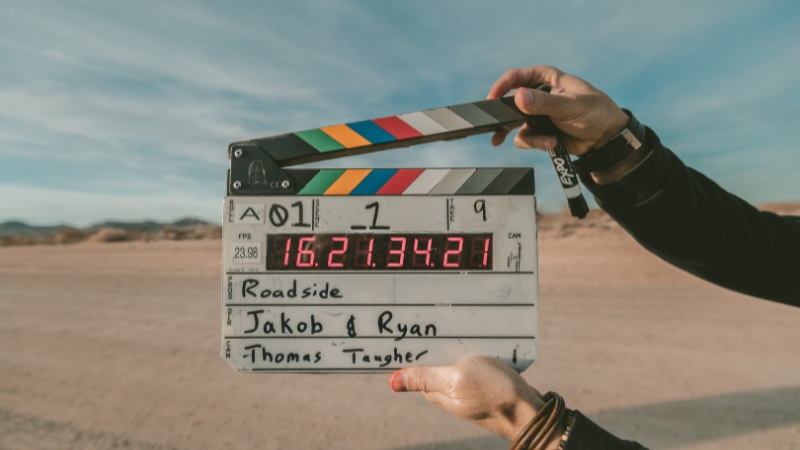Light up the Screen: Techniques in Film Lighting

From the shadowy light manipulations of horror movies, that haunt your imagination, to the warm inviting glow of budding young love, the arrangements of lighting setups in film have proved to have unlimited possibilities.
Lighting is responsible for creating the mood and atmosphere of any given film. It helps set an emotion, whilst guiding the audience's gaze and reaction to interpret specific feelings and meanings. There are, however, certain techniques and lighting angles one can familiarise themselves with in order to achieve their desired effect (whatever that may be).
Three-Point Lighting Setup: Starting With the Basics
Front, side and back! This three-directional lighting setup will shape your subject and distinguish it from the background. This ensures that you are not left with a flat frame. This is achieved using 3 types of lighting: key lighting, fill lighting, and backlighting.
-
Key Lighting
This is the main and brightest light in the three-point setup. It can be positioned anywhere around the subject, helping illuminate and brighten. Remember to steer clear of placing it too close to the camera, otherwise, you will be left with a flat and featureless subject.
High Key Lighting
If you are looking to create a tone of promise, optimism and hope, heighten the key lights, increase the fills, and use a lot of diffusions. High key lighting will create a brightly balanced frame.
Low key Lighting
On the other hand, if you are aiming for a dark dramatic scene, foregrounding the shadows and dark tones could create that perfect ominous movie mood.
Make your light sources smaller, and instead of full fill lights, opt for bounce cards to reflect off of and fill in the rest of the frame.
-
Fill Lighting
This light is placed opposite to your key light. Less powerful than key light, its purpose is to cancel out shadows that the key light may create. It is also used to highlight objects that are behind the main subject, in order to bring attention to it.
Think about those scenes in movies where the camera blurs out the subject and the background comes into focus (known as rack or pull focus).
-
Backlighting
Placed behind and at a higher level than the actor or the object, backlighting creates a more three-dimensional feel to any frame.
Practical Lighting
A candle, lamp, torch, a television, these set dressing props can be used to light a scene for wide or long shots or to subtly illuminate your subject.
Practical lighting gives a depth of field to a scene and can be adjusted in various ways to produce desired effects. Is it too bright? Use a dimmer! Is it too dull? Use hidden, motivated light to increase the strength! Is it not quite the right tone? Change the bulbs to colour correct the light!
Motivated Lighting
You can imitate natural lighting sources or intensify practical lights with motivated lighting. The intention is for it to appear natural and part of the scenic elements on the screen. Use coloured gels and filters for a soft silver moonlight, or flags and bounce cards for a more natural sunset glow.
Hard Lighting
Think drama - harsh shadows and highlights, sharp edges and bold silhouettes. Hard lighting is brilliant for emphasising and drawing the audience's attention towards the subject or to specific parts of the frame.
Bright direct sunlight or a strong, small light source will do the trick. Using a backlight, with a soft fill, will also help create this effect. Make it black and white and you've got yourself a film noir!
Soft Lighting
The larger and further the light source, the softer it becomes. Soft lighting gives off an air of youth and tenderness, perfect for conveying those romantic emotional scenes.
Using high key lighting, generous fill lights and plenty of diffusions will make the light appear as if it is curving around the subject and create a subdued soft effect. Soft lighting portrays characters in a pleasing manner. Think lovers, friends, a child or a beautiful woman, not a villain or a secret agent!
Bounce Lighting
Bounce lighting is light that is reflected off white cards or reflectors and bounced back onto the subject.
Supporting any type of film lighting, bounce light highlights a subject and produces a substantial area of distributed light across a frame.
Side Lighting
Imagine a dramatic, moody scene with half of the actor's face highlighted and the other half with unidentifiable shadowy features.
Placing the lighting on the side of the actor or object creates contrast and can add an air of mystery to a scene. Hard or soft shadows are optional with the lack or aid of diffusion.
Natural Lighting
Use what you've got! That, however, does not mean that minimal work will be involved.
You can use your given light to produce numerous effects, manipulating and altering it to suit the scene. Bounce boards can reflect the light, while black flags can block it out.
Scouting potential locations before filming is also important in determining how the light will hold up. Remember that the lighting can change by the hour. Therefore, if you do not get your shot within that time frame, you may have to come back another day.
Ambient Lighting
Like natural lighting, ambient lighting is using light that is already present at the shooting location.
You will have to:
-
Take note of the time of day and the direction of the light for every frame
-
Location scout beforehand
The planning of lighting in film may seem excessive, but the more time spent on execution means reduced time spent in post-production where changes will be harder to bring about. Therefore, take the time to get your light right!
Are you ready to light up the screen? Click here to view our light control equipment, booms and stands!